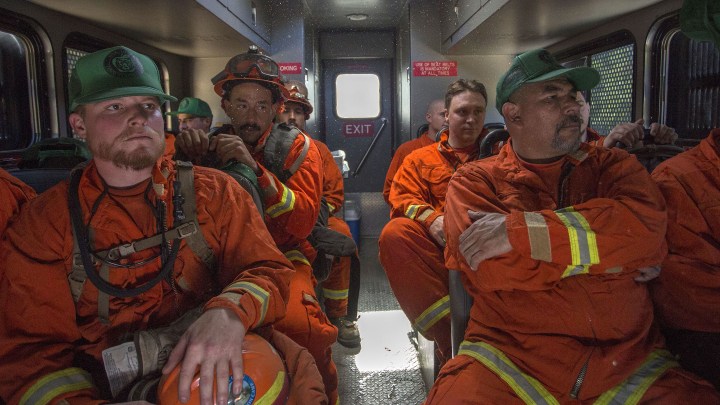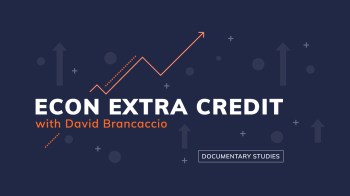
The hidden side of the prison labor economy
The hidden side of the prison labor economy

This interview is part of our series Econ Extra Credit with David Brancaccio: Documentary Studies, a conversation about the economics lessons we can learn from documentary films. We’re watching and discussing a new documentary each month. To watch along with us, sign up for our newsletter.
There’s a striking scene in Brett Story’s documentary “The Prison in 12 Landscapes” that captures the complicated and exploitative aspect of rehabilitative prison labor programs: An incarcerated firefighter, explaining how they’re not allowed to talk to others on the job, adds that — because of their criminal record — they have a slim chance of becoming a firefighter upon leaving prison.
It’s an experience that’s common not just for prison firefighters, but for people who work making telemarketing calls, care for elderly or infirm people in prison, and more, according to UC Hastings law professor Hadar Aviram.
“There are many limitations on people working in these occupations, and because of that, the public is unaware of the fact that many of the people that they interact with every day are working as incarcerated people,” Aviram said in an interview with “Marketplace Morning Report” host David Brancaccio.
While there are laws in place to protect formerly incarcerated people from hiring discrimination, Aviram noted that many barriers to employment remain, including the scarcity of rehabilitative work programs and their stringent terms and conditions.
“The programs themselves are very selective, it’s difficult to get into them, not all of them are evidence-based,” Aviram said, “so oftentimes they will train people to do jobs that they can’t actually get on the outside.”
Below is an edited transcript of Brancaccio’s conversation with Aviram on the other jobs prisoners commonly do, the challenges facing formerly incarcerated people who are trying to find work and what Aviram thinks can be done to increase their chances of finding meaningful jobs that take advantage of skills learned while in prison.
David Brancaccio: In this film, we see a California wildfire at first. It turns out that one of those working on the fireline, to keep it from spreading, is a person in prison, in a special prison work program. Would a program like that be common or fairly rare?
Hadar Aviram: Here in California, it’s extremely common. And among the people who saved probably thousands of lives in the last summer, when we had the wildfires, were many, many incarcerated people working as firefighters.
“The range of occupations that people have in prison”
David Brancaccio: It’s interesting, right? Because often people don’t know that, in fact, there’s a ban on people who are incarcerated speaking with members of the public while out there fighting the fire.
Aviram: Yes, there are many limitations on people working in these occupations and, because of that, the public is unaware of the fact that many of the people that they interact with every day are working as incarcerated people. A lot of the customer service on the phone, a lot of the furniture, things that are being manufactured — sweatshirts for dozens of Ivy League universities are made in a prison in Kansas, where people are getting paid 50 cents a day. It’s really astounding, the range of occupations that people have in prison. And I think that firefighting is an especially interesting example, because they are saving lives and they are working shoulder to shoulder with professional, non-incarcerated firefighters. The big irony, of course, is that then they get out and, at least until recently, they couldn’t get a job as firefighters, despite being trained, because they have a criminal record.
When formerly incarcerated people are unable to get jobs
Brancaccio: I mean, that’s the thing. There’s, of course, a move that we’ve spent some time covering on this program to ban employers from, for the first initial part of a job application, asking if you have a criminal record, but employers have a way finding out anyway, or it comes up during the background check.

Aviram: Absolutely. I was one of the big pushers for this kind of, we call it “ban the box” initiatives, to screen people without knowing their criminal record. But, it turns out, colleagues of mine at the Urban Institute did a study and they found out that rather than employers discriminating on the basis of criminal records, they have started discriminating on the basis of race as a proxy for criminal records. So, for example, they’ll get job applications, and they don’t know which of the people have a criminal record, but they will interview the person called “Brad” rather than the person called “Jamal,” under the assumption that they are using this as a proxy for the criminal record that they don’t have an access to. It’s very frustrating, because you’re trying to create equal opportunities for everybody, but these things have such a protean quality that they pop up no matter what kind of protections you introduce in the workplace.
“Oftentimes prisons turn to these work programs because they think they’re going to be rehabilitative or whatever. But for the most part it’s economic considerations of the prison itself.”
Hadar Aviram, UC Hastings law professor
Brancaccio: What do you do about that? I mean, you know, there’s an ongoing national discussion, at some level, about what we’re addressing here. But, in part, when people have worked alongside people that they find out have criminal records, and they see firsthand that they’re like the rest of us, sometimes that can help break down these stereotypes?
Aviram: Absolutely. And this is a truth that has been found in studies all over. I mean, people have done studies, for example, of members of fundamentalist churches that, you know, will be railing against single mothers and gay people, but then they have a gay uncle or a niece who’s a single mom and they love them to bits, and that softens, a little bit, this approach.
And the same thing holds for people with criminal records. I just saw a study done at a college where there was a strong correlation between students who personally knew fellow students who were formerly incarcerated and their opinions about: Would they befriend somebody with a criminal record? Would they be willing to date somebody who had been in prison? So, truly, personal acquaintances and education and exposure is the most important thing that we can do to break down these barriers.
Brancaccio: Back to this notion of labor done by people in prison: When the phone rings at our house, it could be someone who is incarcerated at the other end of the line?
Aviram: Yes, absolutely. This is just one of many, many, many occupations that people engage in in prisons. Phone solicitation, customer service, a lot of manufacturing of everyday items that you wouldn’t even have an idea come from prison. And, of course, a lot of the work inside prisons. I don’t know that a lot of people know this: We have a high population of people who are aging and infirm in prison. And oftentimes the people taking care of them are trained caregivers who are incarcerated themselves. So a lot of the things that we think the state is providing, it’s actually people from inside the prison who are incarcerated themselves who are doing it.
Is prison labor, by definition, exploitative?
Brancaccio: What’s your sense, having studied this — I mean, is it, by definition, prison labor, exploitative? I mean, no one’s paid market rates for that labor.
Aviram: This is a complicated question, because there’s the world that we would want to live in, in which everybody gets minimum wage and in which you are actually trained for the reality of the marketplace. And there’s the realities of the world we’re in, in which prison labor, to different extents, is exploitative, and we therefore try to sort of improve people’s lot within the conditions that they’re in.
We have to keep in mind the fact that, to some extent, prison labor is training people for conditions in the market on the outside. But the problem is that oftentimes prisons turn to these work programs because they think they’re going to be rehabilitative or whatever. But for the most part it’s economic considerations of the prison itself. The programs themselves are very selective, it’s difficult to get into them, not all of them are evidence-based, so oftentimes they will train people to do jobs that they can’t actually get on the outside. Up until recently, the firefighting was one such example, but there are many other examples. The programs that do have occupations where people can work on the outside, like marine technology or carpentry, are highly selective; very, very few people can get in. Overall, a more realistic prospect for people coming out is to become independent contractors and work for themselves.
The kind of work formerly incarcerated people end up doing
Brancaccio: That’s what people end up doing? Working for themselves?
Aviram: Exactly. For example, you’ll find people that are putting together landscaping companies, house work companies. And there are some examples that are really amazing, of nonprofits that people have put on the outside, where they’re working in the marketplace and just doing amazing things. Right next to Hastings, which is where I teach, is a neighborhood called the Tenderloin in San Francisco, which, during the pandemic, became pretty much an open-air drug market — lots of homeless people, lots of misery, mental health, substance abuse, oftentimes people overdosing. And the mayor was upset by this, and a couple of times they sent the police to clean up the neighborhood with everything that stems from that. That was extremely difficult, because there were no solutions for people other than just sort of cleaning up the aesthetics.
And then a nonprofit stepped in called Urban Alchemy. They operate public restrooms, which is incredibly important in these kinds of neighborhoods. They operated safe sleeping sites during COVID. They calmed down violence, they actually revived people with Naloxone who had overdosed multiple times every week. They did amazing things. And what enables them to do this work more effectively and more peacefully than the police, and almost without any show of force, is the fact that they are former lifers, that the people who work at Urban Alchemy acquired these peacemaking and mentoring skills that they use every day on the job in decades in prison. They were elders and mentors on the yard when they were inside, and they retain this kind of calm mentorship role on the outside. And they have done such an amazing job that the change in energy in the neighborhood is palpable.
Brancaccio: Those are special skills that are in demand. It’s a shame that some employers don’t fully recognize this.
Aviram: Exactly. There are many ways in which we look at a criminal record or a previous prison stay as a liability. This is of course difficult, because at any given moment, 1% of the entire population of the United States is incarcerated. So we have a lot of people who actually have acquired skills and strengths where they were that we can use in the marketplace. I’m not just thinking about occupations that are entry-level jobs, I’m thinking even about entry into, say, the California bar, as lawyers. Think about what somebody brings in, coming in with an insider perspective on a criminal justice system, reassuring their clients about what’s going to happen to them, you know, being able to present a realistic perspective. There are so many strengths that you acquire.
One of the most successful programs we have in California is called marine technologies, it’s people who work underwater fixing ships and underwater structures. And this is partly a skill where it’s a great advantage to be used to being in a very overcrowded environment. This is difficult for a lot of people. But people, unfortunately, who spent time in our grossly overcrowded prisons have acquired this skill. This is a market strength that is being undervalued and stigmatized for no good reason.
Brancaccio: I was reading about that marine program. Recidivism, going back to the ways of crime, is near zero for people who’ve gone through that program.
Aviram: Those are good jobs. If you get a job like that, there is no reason for you to commit crime, because you have gainful employment. We have to think more evidence-based about these kinds of programs and strengths in the market and prepare people for that.
Brancaccio: Those programs often can be expensive within the prison. Sometimes when budgets are tight, as you’ve written, that’s the program that gets cut.
Aviram: Exactly. It’s one of the downsides. And this is something that I wrote in my first book “Cheap on Crime,” that we, overall, saw the prison population shrink since 2009. This was a result of the the recession of 2008. But one of the side effects of that that was more sinister was that there were drastic cuts to rehabilitative programming. And that created a big difference, a big gap, between prisons that are set in urban centers, where there’s lots of volunteers and do-gooders that step in and create these programs. Here, for example, in San Quentin [State Prison], we have Silicon Valley entrepreneurs volunteering to teach people the internet, which is very difficult when you don’t have internet behind bars. So we have all of this programming because of the volunteers, because they’re stepping in to fill in the gaps that the state cannot fill. But there are many, many prisons in the United States that are located in these remote, rural locations, very, very difficult to get there, and very difficult to get quality programming that actually prepares people to get good jobs once they get released.
There’s a lot happening in the world. Through it all, Marketplace is here for you.
You rely on Marketplace to break down the world’s events and tell you how it affects you in a fact-based, approachable way. We rely on your financial support to keep making that possible.
Your donation today powers the independent journalism that you rely on. For just $5/month, you can help sustain Marketplace so we can keep reporting on the things that matter to you.















